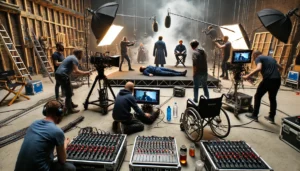
The Making of a UK Telefilm
Behind the Scenes: The Making of a UK Telefilm
Introduction
The UK has a rich tradition of producing high-quality telefilms—films made for television rather than theatrical release. These productions have gained international recognition for their strong storytelling, talented actors, and high production values. From thrilling crime dramas to historical period pieces, UK telefilms continue to captivate audiences worldwide.
But what goes on behind the scenes in the making of a UK telefilm? This guide explores the step-by-step process of creating a successful telefilm in the UK, from script development to post-production and distribution.
Step 1: Developing the Concept & Writing the Script
1. Choosing the Genre & Target Audience
Before production begins, filmmakers must decide on the theme and genre of the telefilm. Popular UK telefilm genres include:
Historical Dramas (The Gathering Storm, Elizabeth I)
Crime & Thriller (The Moorside, A Confession)
Romantic Dramas (The Lost Valentine, Sense & Sensibility)
Social Issues & Biopics (The Best of Men, The Duke)
2. Writing the Script
UK telefilms often follow a 90-minute to 2-hour format, requiring a well-structured script.
Writers use industry-standard software like:
Final Draft (widely used by professionals)
Celtx (for collaborative scriptwriting)
Scrivener (for research-heavy biopics and historical films)
3. Script Development & Funding
The script goes through multiple drafts and revisions before approval.
Funding sources include:
BBC Films, Channel 4, ITV, and Sky Cinema commissions.
British Film Institute (BFI) grants for independent telefilms.
Co-productions with international studios (e.g., Netflix, Amazon Prime).
Once the script is finalized, the project moves to pre-production.

Step 2: Pre-Production – Planning the Film
1. Budgeting & Financing
Telefilms typically have smaller budgets than theatrical films, but require detailed planning to ensure high quality.
The budget covers:
Cast & Crew Salaries
Filming Locations & Set Design
Costumes & Props
Marketing & Distribution
2. Casting the Right Actors
Casting directors hire experienced actors from platforms like:
Spotlight (UK’s top casting agency)
The Casting Collective (for extras & background actors)
Some telefilms feature well-known British actors, while others highlight emerging talent.
3. Location Scouting & Set Design
UK telefilms are often filmed on authentic locations rather than expensive studio sets.
Popular filming locations:
London & Manchester (Urban dramas, crime thrillers)
Scottish Highlands & Wales (Period dramas & fantasy films)
Historic Castles & Countryside (Royal and historical films)
4. Costumes & Props
Period dramas require historically accurate costumes.
Modern telefilms focus on realistic set designs to enhance storytelling.
With pre-production completed, the telefilm moves into filming.

Step 3: Production – Filming the Telefilm
1. Cinematography & Camera Work
UK telefilms use cinematic camera techniques despite being made for TV.
Cameras used:
ARRI Alexa (for high-quality digital cinematography)
RED Digital Cinema (for detailed, high-resolution shots)
2. Lighting & Sound Design
Professional lighting setups enhance the film’s visual appeal.
Boom mics and lapel microphones ensure clear dialogue recording.
3. Managing the Shooting Schedule
Telefilms are usually shot in 4-8 weeks, requiring efficient scheduling.
The Assistant Director (AD) ensures that filming stays on track.
Once all footage is captured, the telefilm enters post-production.
Step 4: Post-Production – Editing & Final Touches
1. Video Editing & Color Grading
Editors refine the film using:
Adobe Premiere Pro (for editing sequences)
DaVinci Resolve (for cinematic color grading)
2. Sound Design & Music Score
Foley artists create background sounds to add realism.
Original scores are composed to enhance the emotional depth of scenes.
3. Visual Effects (VFX) & CGI
Used for historical reconstructions, fantasy sequences, and action scenes.
British VFX companies like Framestore and DNEG provide CGI for high-end productions.
After finalizing the film, it moves to distribution.
Step 5: Distribution – Releasing the Telefilm
1. Broadcasting on UK TV Channels
Telefilms are aired on:
BBC One, ITV, Channel 4, Sky Cinema, and BritBox.
Some are later released on Netflix and Amazon Prime.
2. International Streaming & Licensing
UK telefilms are increasingly licensed to global platforms, expanding their audience.
3. Promotion & Marketing
Telefilms are promoted through social media campaigns, trailers, and press interviews.
The Future of UK Telefilms
1. Increasing Popularity of Streaming-Exclusive Telefilms
More UK telefilms are being produced exclusively for Netflix, Disney+, and Apple TV+.
2. AI & Virtual Production Advancements
AI-assisted editing and LED volume screens are improving telefilm production.
3. Diversity & Inclusive Storytelling
UK telefilms are focusing on diverse perspectives and multicultural representation.
Conclusion
Creating a successful UK telefilm requires strong storytelling, meticulous planning, and cutting-edge technology. From scriptwriting and casting to filming and editing, each step plays a vital role in delivering a high-quality production.
With the rise of streaming platforms and global licensing, UK telefilms are reaching wider audiences than ever before. As technology advances, the future of UK telefilms looks brighter and more innovative.
FAQs: The Making of a UK Telefilm
1. How long does it take to produce a UK telefilm?
Most UK telefilms take 4-8 weeks to film and another 2-3 months for post-production.
2. Where can I watch UK telefilms?
You can watch UK telefilms on BBC iPlayer, ITV Hub, Channel 4, Sky Cinema, BritBox, Netflix, and Amazon Prime.
3. What is the difference between a telefilm and a regular film?
A telefilm is made specifically for television rather than a theatrical release but maintains high production values.
4. How are UK telefilms funded?
Funding comes from TV networks (BBC, ITV, Channel 4), BFI grants, co-productions, and streaming services.
5. What are some of the most successful UK telefilms?
Some top UK telefilms include The Gathering Storm, The Moorside, Elizabeth I, and A Confession.